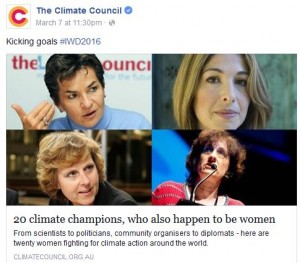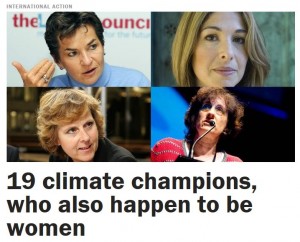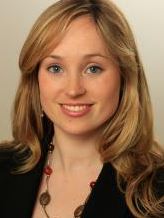Mandrake the Magician has nothing on Tim Flannery & Co when it comes to vanishing acts, from geothermal investors’ equity to those frothing predictions of endless drought and “ghost cities”. But the excision of sceptic Judith Curry from a list of female climate experts takes the cake
 When a three-year-old tells whoppers it can be cute. It’s not so cute if the whopper-tellers are scientist Tim Flannery, aged 60, and his Climate Council. Flannery is Chief Councillor of the crowd-funded body, which is dedicated to “accurate and authoritative information on all aspects of climate change”.
When a three-year-old tells whoppers it can be cute. It’s not so cute if the whopper-tellers are scientist Tim Flannery, aged 60, and his Climate Council. Flannery is Chief Councillor of the crowd-funded body, which is dedicated to “accurate and authoritative information on all aspects of climate change”.
His Council website has this item:
19 climate champions, who also happen to be women… To celebrate International Women’s Day, here’s a list of nineteen women kicking goals in the climate change debate — from scientists to politicians, diplomats, community organisers and more. (My emphasis).
It begins, “This article originally appeared on the International Council for Science’s Road to Pariswebsite.” Click through to that site (a spin-off from the International Council for Science, ICSU) and you find the original was not about 19 women but was headed, “20 women making waves in the climate change debate”.[i]
 Even more mysterious, the Climate Council website has a Facebook prompt (left) headlined:
Even more mysterious, the Climate Council website has a Facebook prompt (left) headlined:
Kicking goals: 20 climate champions, who also happen to be women…From scientists to politicians, community organisers to diplomats – here are 20 women fighting for climate action around the world. Climatecouncil.org.au
But click it and the original 20 women suddenly become the Climate Council’s 19. (below right)
So what’s going on? The ICSU’s 20 women were meant to reflect women’s contribution to the “diversities of the climate debate”. The 20 included distinguished scientist Dr Judith Curry, who doesn’t toe the doomsters’ party line on climate. The Climate Council simply couldn’t bear to list her – even though she has a peer-reviewed publication list of 150+, dwarfing that of the other women cited in the top 20 (or top 19). So the Climate Council simply clipped her from  the list, notwithstanding the ICSU’s copyright.
the list, notwithstanding the ICSU’s copyright.
The Climate Council’s tampering was done without public acknowledgement or apology to the original compilers, namely three editors associated with ICSU and the Stockholm Resilience Centre. The editors in turn had compiled the list by an extra survey in the wake of their unisex survey about top 15 climate news-makers a year ago. That list of 15 included only three women.[ii] The Road to Paris doesn’t say who exactly was surveyed for nominations for its later “20 women” list, but did name 16 individuals who were both “judges” and respondents for the unisex list of 15.
I googled a few of them. They included, for example, Alice Bows-Larkin, Professor of Climate Science & Energy Policy, Manchester University; Max Boykoff, of the Centre for Science & Technology Policy Research, Oregon; Simon Buckle, Policy Director, The Grantham Institute for Climate Change, Imperial College, and at the far end of the alphabet, Professor James Wilsdon, Director of Impact and Engagement, Sheffield University.
We can assume the ICSU/Stockholm’s “20 women” respondents were of comparable weight and lustre.
The Climate Council’s deletion of Judith Curry from the 20 Women list bears a family resemblance to the revered Soviet practice which saw photos that originally included purged-and-shot apparatchiks doctored, the unwanted  individuals’ images made to disappear. At least the Soviets owned the photographs they doctored. The Climate Council doesn’t own the ICSU 20 women list and has no more right to delete a woman it hates than to insert its own choice into the list. Perhaps we’re lucky the Council didn’t decide to re-make the list into 20 by replacing Curry with its winsome CEO Amanda McKenzie (left), who is more the telegenic cutie. That way, the odd, eye-catching numeral 19 could have been avoided.
individuals’ images made to disappear. At least the Soviets owned the photographs they doctored. The Climate Council doesn’t own the ICSU 20 women list and has no more right to delete a woman it hates than to insert its own choice into the list. Perhaps we’re lucky the Council didn’t decide to re-make the list into 20 by replacing Curry with its winsome CEO Amanda McKenzie (left), who is more the telegenic cutie. That way, the odd, eye-catching numeral 19 could have been avoided.
The Climate Council’s monkeying with a third party’s survey-based list hardly validates its claim:
We exist to provide independent, authoritative climate change information to the Australian public. Why? Because our response to climate change should be based on the best science available.
The ICSU comprises 122 national science academies and 31 unions of scientists, e.g. the International Mathematical Union. Among the ICSU’s members is our very own Australian Academy of Science. Expect a high-level stoush when the Australian Academy’s president Andrew Holmes takes Flannery and the Climate Council to task for tampering with the ICSU’s list. Oh, wait! Flannery’s a Fellow of the Australian Academy! Should Holmes expel him, or would that be too drastic? Maybe an internal reprimand would be sufficient? Or is the Australian Academy uninterested in one of its Fellows authorising wanton deletions to an ICSU-copyrighted survey-based ranking of women in climate?
The ICSU list has this to say about Dr Curry – words Flannery and the “scientific” Climate Council felt duty-bound to expunge:
Blogger and scientist favoured by sceptics. Judith Curry is fast becoming the go-to scientist favoured by the more sceptical ends of the climate debate, though she is more than capable of making a name for herself in her own right. An established climate scientist, well known for her research on hurricanes and Arctic ice, Curry is currently Chair of the School of Earth and Atmospheric Sciences at the Georgia Institute of Technology. Troubled by the way those who do not fit with scientific consensus are treated by the scientific community and broader environmental discourse, she regularly speaks up for the role of dissent and free speech in climate science. It is fair to say this doesn’t always win her friends in either science or the green movement. Curry is an active blogger, reflecting her commitment to transparency of the debate within science…
 Pit Dr Curry against other women on the 20 list, and it would be no-contest. The only other listee of similar stature (about 140 publications) is Joanna Haigh FRS, a solar expert and ex-president of the Royal Meteorological Society. Among the others, lightweight author Naomi Klein never managed to finish her BA at the University of Toronto. Sharan Burrow, ex-ACTU boss, makes the list but her credentials stop at “high school teacher”. Listee Naomi Oreskes calls herself a science “historian” and carries on about climate skeptics being the same as tobacco lobbyists. Then there’s US EPA boss Gina McCarthy, who doesn’t know what percentage CO2 comprises in the atmosphere. Annie Leonard is boss of Greenpeace US.
Pit Dr Curry against other women on the 20 list, and it would be no-contest. The only other listee of similar stature (about 140 publications) is Joanna Haigh FRS, a solar expert and ex-president of the Royal Meteorological Society. Among the others, lightweight author Naomi Klein never managed to finish her BA at the University of Toronto. Sharan Burrow, ex-ACTU boss, makes the list but her credentials stop at “high school teacher”. Listee Naomi Oreskes calls herself a science “historian” and carries on about climate skeptics being the same as tobacco lobbyists. Then there’s US EPA boss Gina McCarthy, who doesn’t know what percentage CO2 comprises in the atmosphere. Annie Leonard is boss of Greenpeace US.
The Climate Council not only solicits donations from the public, but these donations are tax-deductible. Perhaps our gutsy Prime Minister could check whether the Council’s tax-deductibility is still appropriate, given that it appears to have hired a green-tinted Mandrake the Magician to enhance a penchant for putting propaganda ahead of science and stuffing inconvenient sceptics down the memory hole.
Tony Thomas blogs at No B-S Here I Hope
_______________________________
[i] The detail reads, “We hope it shows off some of the quiet – and not so quiet – power women do have on this issue, and the diversity of the debate. Gender aside, this list reflects other diversities of the climate debate, with expertise in financial systems, workers’ rights, science, politics, development, media, diplomacy and more.”
[ii] But quelle surprise! The top-15 does include Rajendra Pachauri 70, for 12 years chair of the Intergovernmental Panel on Climate Change, until his abrupt resignation a year ago because of charges involving his alleged 14-month sexual pursuit of an unwilling 30-year-old female researcher at his TERI institute. The 1400-page New Delhi police charge sheet covers four counts including sexual assault, harassment and criminal intimidation. The top-15 list also includes leading skeptic Christopher Monckton, illustrating that the original ICSU lists are independent of value-judgements about the news-makers listed.
